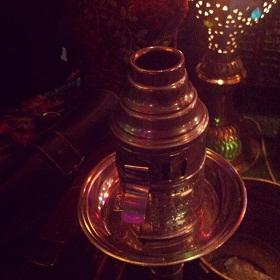Using AI to control energy for indoor agriculture
30 September 2024
Published online 17 October 2012

The habit goes by many names, but whether it's called hookah, shisha, nargile, qalyan, or hubbly bubbly, water pipe smoking is often seen as a less harmful alternative to cigarettes. A growing body of evidence now suggests this is a dangerous assumption.
A water pipe passes the smoke from burning sweet-tasting tobacco through a water filter before inhalation. According to the latest findings published in the journal Respirology, the method may be as harmful to the respiratory system as cigarette smoking.
Mohammad Boskabady of Mashhad University of Medical Sciences, Tehran, led a team that measured lung capacities, coughing frequency, wheezing, chest tightness and phlegm production experienced by water pipe smokers, cigarette smokers, and non-smokers.
Cigarette smokers were further categorized as deep-inhaling or normal inhalation smokers.
Lung function was similarly compromised in all smokers, though to a lesser extent in normal inhalation cigarette smokers. Wheezing, coughing and chest tightness was more prevalent among water pipe smokers compared with normal inhalation cigarette smokers, though not quite as high as among deep inhalation smokers.
Boskabady concludes the effects of water pipe smoking on the lungs are "similar to the effects observed in deep inhalation cigarette smokers."
A previous study also found water pipe smoking increases the likelihood of periodontal disease more than cigarette smoking has been found to.
Smokers of hookah are less likely to believe that the water pipe is dangerous to your health.
While this habit is common in most Middle Eastern countries, there is a dearth of empirical data on perceptions in the region about its health risks. But as the hookah has become more popular in North America and Europe, researchers there are increasingly investigating smokers' attitudes.
Erin Sutfin, an assistant professor at Wake Forest School of Medicine and lead author on a previous study of the prevalence of water pipe smoking in the US, confirmed that "many young adults underestimate the risks of water pipe smoking and incorrectly believe it to be safer than cigarette smoking."
Bengt Arnetz, professor of occupational and environmental medicine at Wayne State University School of Medicine, Michigan, concurs. "Smokers of hookah, as compared to non-smokers of hookah, are less likely to believe that the water pipe is dangerous to your health." He suggested that when considering results from studies such as Boskabady's it was important to note the typical context of water pipe smoking. It is usually seen as a social activity, with groups of smokers gathering together for many hours.
According to the World Health Organization (WHO), a typical hour long bout of water pipe smoking is equivalent to inhaling the smoke of 100-200 cigarettes.
"When a person smokes hookah, they typically are exposed to the exhaled smoke from the hookah device and other smokers. This adds the aggregate exposure to tobacco smoke and its many toxicants and carcinogens," Bengt said.
He is planning to conduct a study on the perceived risks of water pipe smoking among athletes and non-athletes in Egypt. "We want to determine not only an estimate of hookah prevalence, but also how athletes' lifestyles and performances are perceived to be affected by water pipes," he says.
Meanwhile, there is an increasing call for the raising of awareness over the health risks of water pipe smoking. "There is a strong need for education and policies that address this form of tobacco use," Sutfin said.
Bengt also emphasized the need for public health campaigns focusing on water pipe smoking "especially among our young people."
The WHO wants to go further than raising awareness. Fatimah El-Awa, the regional adviser for the Tobacco Free Initiative at WHO's Office for the Eastern Mediterranean Region, insists that regulation is essential. "Awareness must go hand in hand with regulating the use of shisha with the measures included in the WHO Framework Convention on Tobacco Control," she said.
These measures would bring water pipe smoking under the same regulatory framework as cigarette producers, such as requiring them to use pictorial health warnings on their packaging and labeling.
doi:10.1038/nmiddleeast.2012.148
Stay connected: